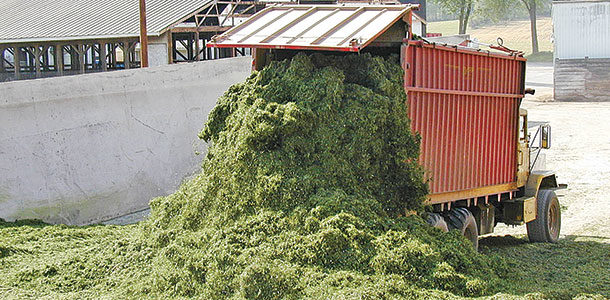“We don’t need to know how it works – just that it does work” seems to have been the mantra for many people.
However, when it comes to fermenting forages, what you don’t know could hurt you (or ruin your haylage).
Forage plant cells respire
Cell respiration (conversion of sugars into energy) is a normal activity in all living cells (Figure 1). They respire to keep themselves alive. Plant cells in mowed forages are still alive and therefore respire until they run out of oxygen or become too dry.

There are several external factors that affect the rate at which plant cells respire. First, respiration goes faster and uses more sugar as temperature increases. Second, respiration is faster at higher plant moisture rather than lower plant moisture.
So immediately after mowing (80 percent moisture), respiration is happening much faster than when the forage is ready to be chopped or baled as haylage (at 45 to 60 percent moisture). Third, as oxygen content of the air surrounding the cell declines, so does the rate of respiration.
Fermentation is completed by bacteria that require an anaerobic (without oxygen) environment. Once the forage has been placed in an airtight structure, cell respiration depletes the oxygen in the forage mass, creating an anaerobic environment for fermentation to begin.
The time it takes to deplete the forage mass of oxygen depends on the rate of respiration and the amount of oxygen in the forage.
For example, dryer forages tend to require more time to become anaerobic because they do not pack as well and consequently contain more oxygen (more air pockets), and respiration is going slower than in a wetter forage.
Extended respiration uses more sugars, resulting in lower forage quality, and raises the forage temperature more than a brief respiration period. Chopping or baling haylage at the correct moisture and getting it in a sealed structure quickly will preserve the forage’s sugars and minimize temperature increases.

The reduced forage carbohydrate content associated with prolonged respiration can jeopardize the next step in haylage-making: fermentation.
This is because the bacteria that ferment the haylage have a strict diet of sugars. If too many sugars are used during respiration, then there will be insufficient sugars to completely ferment the forage. In addition, prolonged respiration allows the forage temperature to increase, which stimulates mold growth in the forage.
Minimizing the amount of oxygen in the forage mass when it is in a sealed structure is the best way to shorten the respiration period and avoid unnecessary mold growth, quality loss or a potential silo fire.
Fermentation
Once oxygen is depleted in the forage, fermentation begins. Fermentation is the lowering of the pH in the forage to a point where no organism (mold or bacteria) can function. The pH is lowered by lactic acid, which is a byproduct of lactobacillus bacteria.
The lactobacillus bacteria are on the forage when it is mowed and multiply rapidly until the forage is fermented. Lactobacillus bacteria consume forage carbohydrates for their energy source and excrete lactic acid (Figure 2).

The lactobacillus bacteria continue to produce lactic acid and lower the forage pH (4.3 to 5) until they can’t function anymore (Figure 3). At this pH level, the forage is fermented and can exist basically unchanged for many years as long as it is not exposed to oxygen.
Clostridia bacteria
Clostridia bacteria are also on the forage when it is mowed and are put in a sealed structure with the forage. The more soil on the forage, the more clostridia bacteria on the forage.
Clostridia bacteria consume forage carbohydrates, forage proteins and even lactic acid as their energy source and excrete butyric acid (Figure 4). Butyric acid is associated with rotten or putrefied haylage.
 Situations that might benefit clostridia growth are insufficient forage carbohydrate levels (rain while forage is wilting, extended respiration period due to poor packing, seepage due to excessive forage moisture) to complete the fermentation process or low lactobacillus bacteria levels.
Situations that might benefit clostridia growth are insufficient forage carbohydrate levels (rain while forage is wilting, extended respiration period due to poor packing, seepage due to excessive forage moisture) to complete the fermentation process or low lactobacillus bacteria levels.
Looking at your haylage-making process
1. What is the carbohydrate content of forage?
Why it matters
- Carbohydrates are essential for plant cell respiration, which depletes the oxygen in the haylage. Oxygen must be gone before the fermentation process can begin.
- Carbohydrates are also the main food source for lactobacillus bacteria. These bacteria produce lactic acid that lowers the haylage pH until no bacteria or molds can grow in the haylage.
Factors that affect level of carbohydrates
- As curing time increases, carbohydrates decline because of extended plant cell respiration.
- As time between chopping or baling and sealing in a silo structure increases, carbohydrates decrease.
- Extended periods of rain on curing forage can leach carbohydrates out of the mowed plant.
2. What is the forage protein content?
Why it matters
- Proteins buffer the ability of lactic acid to lower silage pH. So the higher the forage protein content, the more acid required to ferment the silage.
Factors that affect protein levels
- Less mature forage has higher protein content than more mature forages.
- Legumes tend to have higher protein content than grasses.
3. What is the forage moisture content?
Why it matters
- Seepage caused by excessive moisture carries with it carbohydrates and lactic acid. Both of these are essential in the fermentation process.
- Excessive moisture dilutes the ability of lactic acid to lower silage pH.
- Forage with low moisture content is difficult to pack tightly. This leaves additional oxygen in the forage and extends respiration and the time needed to deplete oxygen. Oxygen must be gone before the fermentation process can begin.
4. How tightly is the forage packed in the silo?
Why it matters
- Poor packing leaves additional oxygen in the forage and extends respiration and the time needed to deplete oxygen. Oxygen must be gone before the fermentation process can begin.
Factors that affect level of packing
- Chopping or baling below the recommended moisture level makes it difficult to adequately pack.
- As particle length increases, it becomes more difficult to adequately pack.
5. What is the level of lactobacillus bacteria in the forage?
Why it matters
- Lactobacillus bacteria produce lactic acid that lowers the silage pH (ferments the silage) until no bacteria or molds can grow in the silage. These bacteria multiply rapidly on the forage between the time the forage is mowed and chopped or baled.
Factors that affect levels of lactobacillus bacteria
- Lactobacillus multiplies slower at cooler temperatures. Early spring or fall harvests (cooler temperatures) may result in low lactobacillus levels.
- Rain can wash lactobacillus bacteria off the mowed forage, reducing levels of lactobacillus bacteria going into the silo.
By now your head is probably spinning with all the things that can affect your haylage.
If you go to the website below, you can adjust levels of forage carbohydrates, protein, moisture, oxygen and lactobacillus within an interactive model and watch the fermentation process and see how these factors affect haylage fermentation. FG
(See Understanding Silage Fermentation: Backround Information)
PHOTO 1: Forage with low moisture content is difficult to pack tightly and leaves air pockets. This leaves additional oxygen in the forage and extends respiration. Oxygen must be gone before the fermentation process can begin. Photo courtesy of Marvin Hall.
PHOTO 2: Once the forage has been placed in an airtight structure, cell respiration depletes the oxygen, creating an anaerobic environment for fermentation to begin. Photo courtesy of Mike Dixon.

-
Marvin Hall
- Forage Extension Specialist
- Penn State University
- Email Marvin Hall













